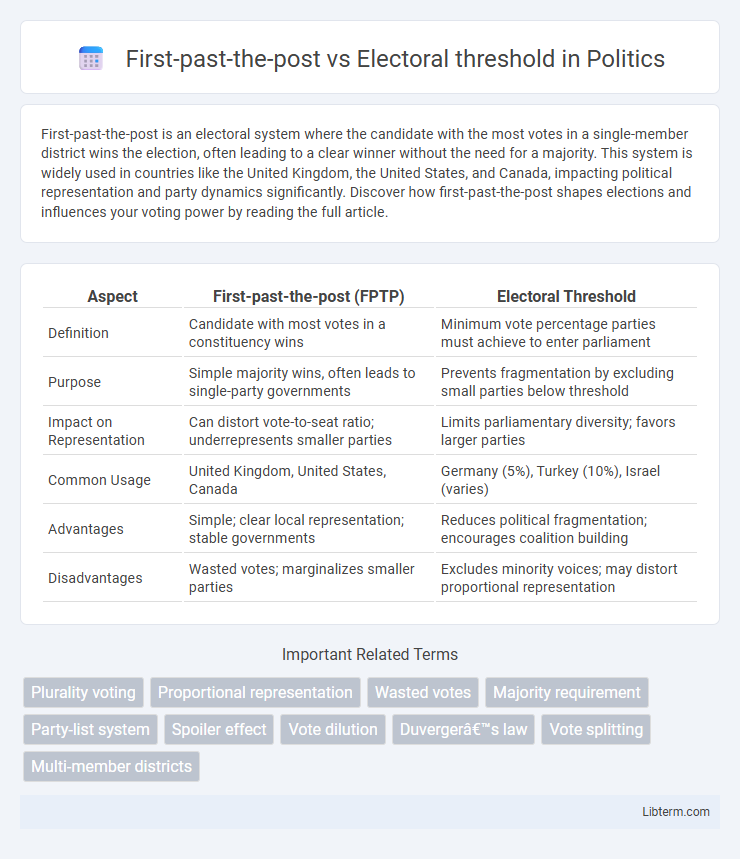First-past-the-post is an electoral system where the candidate with the most votes in a single-member district wins the election, often leading to a clear winner without the need for a majority. This system is widely used in countries like the United Kingdom, the United States, and Canada, impacting political representation and party dynamics significantly. Discover how first-past-the-post shapes elections and influences your voting power by reading the full article.
Table of Comparison
| Aspect | First-past-the-post (FPTP) | Electoral Threshold |
|---|---|---|
| Definition | Candidate with most votes in a constituency wins | Minimum vote percentage parties must achieve to enter parliament |
| Purpose | Simple majority wins, often leads to single-party governments | Prevents fragmentation by excluding small parties below threshold |
| Impact on Representation | Can distort vote-to-seat ratio; underrepresents smaller parties | Limits parliamentary diversity; favors larger parties |
| Common Usage | United Kingdom, United States, Canada | Germany (5%), Turkey (10%), Israel (varies) |
| Advantages | Simple; clear local representation; stable governments | Reduces political fragmentation; encourages coalition building |
| Disadvantages | Wasted votes; marginalizes smaller parties | Excludes minority voices; may distort proportional representation |
Introduction to Electoral Systems
First-past-the-post (FPTP) and electoral threshold represent two fundamental mechanisms within electoral systems that shape how votes translate into political representation. FPTP awards victory to the candidate receiving the most votes in a constituency, often leading to single-party majorities, while electoral thresholds set minimum vote percentages parties must achieve to gain seats in proportional representation systems, preventing fragmentation. Understanding these concepts is crucial for analyzing the balance between effective governance and fair representation in democratic processes.
What is First-Past-the-Post (FPTP)?
First-Past-the-Post (FPTP) is an electoral system where the candidate with the most votes in a single-member district wins the seat, regardless of whether they achieve an absolute majority. This plurality voting method often leads to a two-party dominance and can result in disproportional representation compared to the popular vote. Unlike proportional representation systems with an electoral threshold, FPTP does not require a minimum percentage of votes for a party to gain representation.
Understanding Electoral Thresholds
Electoral thresholds set a minimum percentage of votes that political parties must achieve to gain representation in a legislature, preventing fragmentation and promoting stability. Unlike first-past-the-post systems that reward individual candidates with the most votes per district, thresholds apply to overall party vote shares in proportional representation systems. Understanding electoral thresholds is crucial for analyzing how they influence party strategies, voter behavior, and legislative composition in multiparty democracies.
Core Differences: FPTP vs Electoral Threshold
First-past-the-post (FPTP) is an electoral system where the candidate with the most votes in a single-member district wins, often leading to a winner-takes-all outcome and potentially underrepresenting smaller parties. Electoral thresholds, commonly used in proportional representation systems, require parties to secure a minimum percentage of the overall vote--such as 5%--to gain seats, preventing fragmented legislatures and promoting party consolidation. The core difference lies in FPTP emphasizing individual district victories, while electoral thresholds focus on vote share thresholds to determine party representation.
Impact on Political Party Representation
First-past-the-post systems often lead to a disproportional representation favoring larger political parties, resulting in a two-party dominance and underrepresentation of smaller parties. Electoral thresholds in proportional representation systems prevent fringe or very small parties from gaining seats unless they surpass a predetermined vote percentage, fostering political stability but limiting diversity. The choice between these systems significantly influences the political party landscape by shaping the inclusiveness and plurality of legislative bodies.
Effects on Voter Behavior
First-past-the-post (FPTP) systems often incentivize strategic voting, where voters choose the most viable candidate rather than their preferred one to avoid wasting votes, leading to a two-party dominance. Electoral thresholds in proportional representation systems discourage support for smaller parties below the minimum percentage, motivating voters to consolidate support around larger parties to ensure their vote influences seat allocation. Both mechanisms impact voter behavior by encouraging tactical decisions to maximize electoral influence and reduce the likelihood of wasted votes.
Advantages of First-Past-the-Post
First-Past-the-Post (FPTP) promotes strong, stable governments by often producing clear majorities, reducing the need for coalition negotiations. The simplicity of FPTP enhances voter understanding and expedites vote counting, leading to faster election results. FPTP also strengthens the link between constituents and their representatives, fostering accountability and localized representation.
Pros and Cons of Electoral Thresholds
Electoral thresholds prevent political fragmentation by requiring parties to secure a minimum percentage of votes, typically 3-5%, to gain legislative representation, thus promoting stable governance and clearer policy mandates. However, high thresholds risk marginalizing smaller or emerging parties, potentially distorting proportional representation and reducing voter diversity in parliament. Balancing threshold levels is crucial to maintain both effective government formation and fair minority representation.
Global Examples and Case Studies
First-past-the-post (FPTP) systems, used in countries like the United Kingdom, India, and Canada, enable straightforward winner determination by awarding seats to candidates with the most votes in single-member districts, often resulting in majority governments but limited representation for smaller parties. Electoral threshold systems, common in proportional representation models such as Germany's Bundestag (5% threshold) and Israel (3.25% threshold), aim to prevent excessive party fragmentation by excluding parties that fail to reach a minimum vote percentage, thereby balancing representativeness and governability. Case studies reveal that while FPTP fosters stable majority rule, electoral thresholds enhance party system clarity and coalition formation, though thresholds set too high risk disenfranchising minority voices.
Conclusion: Choosing the Right Electoral System
Selecting the right electoral system depends on balancing representation with governance stability. First-past-the-post tends to favor major parties and clear winners, enhancing decisiveness but potentially marginalizing smaller groups. Electoral thresholds safeguard against political fragmentation, yet too high a bar can exclude minority voices, making the choice context-dependent for achieving fair and effective democracy.
First-past-the-post Infographic

 libterm.com
libterm.com